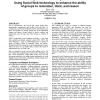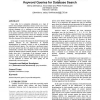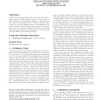SIGMOD
2009
ACM
14 years 11 months ago
2009
ACM
In the rank join problem we are given a relational join R1 1 R2 and a function that assigns numeric scores to the join tuples, and the goal is to return the tuples with the highes...
100
click to vote
SIGMOD
2009
ACM
14 years 11 months ago
2009
ACM
We are experiencing a new Social Web, where people share, communicate, commiserate, and conflict with each other. As evidenced by systems like Wikipedia, twitter, and delicious.co...
SIGMOD
2009
ACM
14 years 11 months ago
2009
ACM
Large collections of documents are commonly created around a database, where a typical database schema may contain hundreds of tables and thousands of columns. We developed a syst...
SIGMOD
2009
ACM
14 years 11 months ago
2009
ACM
Enabling keyword queries over relational databases (KQDB) benefits a large population of users who have difficulty in understanding the database schema or using SQLs. However, sin...
SIGMOD
2009
ACM
14 years 11 months ago
2009
ACM
Keyword search is recognized as an important technique to unlocking the information found in both structured and semistructured information. With XML as the data model and XQuery ...
SIGMOD
2009
ACM
14 years 11 months ago
2009
ACM
An approximate search query on a collection of strings finds those strings in the collection that are similar to a given query string, where similarity is defined using a given si...
SIGMOD
2009
ACM
14 years 11 months ago
2009
ACM
Users often try to accumulate information on a topic of interest from multiple information sources. In this case a user's informational need might be expressed in terms of an...
SIGMOD
2009
ACM
14 years 11 months ago
2009
ACM
Existing works in XML keyword search have addressed the problem of finding matching results of a query. However, user input queries always contain irrelevant or mismatched terms, ...
SIGMOD
2009
ACM
14 years 11 months ago
2009
ACM
We propose a language-model-based ranking approach for SPARQLlike queries on entity-relationship graphs. Our ranking model supports exact matching, approximate structure matching,...
SIGMOD
2009
ACM
14 years 11 months ago
2009
ACM
Current semi-structured keyword search and natural language query processing systems use ad hoc approaches to take advantage of structural information. Although intuitive, they ar...



